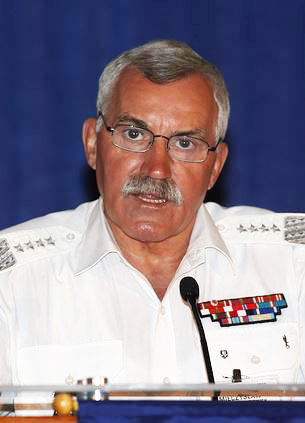Transformation, Coalitions and Interoperability
East: Joint Warfighting 2013 Online Show Daily, Day 2
Everything that’s old is new again.
Gen. Mieczyslaw Bieniek, Polish army, deputy supreme allied commander transformation, NATO, set the tone of the second day of the East: Joint Warfighting 2013 conference in his morning address to attendees by pointing out that the challenge now is to find the best possible way to meet warfighters needs in a complex environments will less money. The Allied Command Transformation’s (ACT’s) view is that partnerships among allies must increase and its ability to collaborate anywhere around the world must grow to meet this challenge.

Gen. Mieczyslaw Bieniek, Polish army, deputy supreme allied commander transformation, NATO
The decrease in many countries' defense budgets demands what the general called “smart defense,” which includes identifying technical shortfalls, gathering ideas from all NATO nations about how to address these shortfalls and then developing those ideas. In addition, NATO’s Connected Forces Initiative, or CFI, is focusing on developing personnel as well as interoperability. Additional multinational training exercises over the next three years will encourage cooperation, he said.
The Wednesday morning panel discussion also centered on the need for multinational collaboration. While the term coalition used to be used at every turn, as in former Vice President Dick Cheney’s constant references to missions in Afghanistan as “coalition operations,” it has lost its luster.
Vice Adm. William Douglas Crowder, USN (Ret.), former deputy chief of naval operations for operations, plans and strategy, opened the panel discussion with a few questions, including “Is ‘coalition’ a military term or simply a political one now?” Andrew Shapiro, former assistant secretary for political-military affairs, U.S. State Department, said that the decision to form or enter a coalition is definitely a political one. While in some cases this is because of relationships formed years ago, even this situation is changing and will continue to change, Shapiro said. Nations that join in coalitions for one operation may decide to opt out of a subsequent one.
And as funding decreases continue, the question about who will pay the costs of multinational operations will arise more often. “Oftentimes, our partners can’t afford to do more. But the U.S. system isn’t set up to do more to help allies increase their abilities to help, such as assisting them improve their technologies,” Shapiro related.
Vice Adm. Kurt W. Tidd, USN, director for operations (J-3), Joint Staff, offered a different point of view. While many speak of the future in terms of doom and gloom, he believes that austerity is a relative term when it comes to resources. No matter the budget, allies will continue to rely on U.S. forces.
That said, the admiral pointed out that one shift that will occur is the relationship between the U.S. government and the military. In the past, political leaders gave the military a mission and the resources to accomplish that mission. Now, the military will need to explain to political leaders what it can accomplish with the resources it has been given, he stated.
During his luncheon keynote address, Gen. Robert W. Cone, USA, commanding general, U.S. Army Training and Doctrine Command, shared that the lessons learned from the military operations that took place during the past decade demonstrate that the military was not as prepared as it should have been for the wars in Iraq and Afghanistan.
While technologies and air power kept the troops connected and protected, commanders and troops were not ready for the human dimension of the conflict. And although established concepts such as network-centric warfare and the subsequent digital divisions led to rapid decisive operations, the nature of war remains a clash of wills that are inherently human. Allied forces did not fully appreciate the human aspects of the conflicts and did not anticipate the adversary’s abilities to adapt to the changes in tactics and strategies that were aimed at defeating them. “We need to prepare the land forces so they have a good understanding of the human domain,” Gen. Cone said.
Joint interdependence is one way to address some of these lessons learned. “Everything we do has to be linked to national security objectives,” the general said. To this end, the Army is facing its biggest challenge with new ideas. “This is the most digitally enabled generation of soldiers we’ve ever had. We have to use the tools we have today that are low overhead, such as apps and mobile devices, to train this generation,” he offered.
The military’s challenge when communicating with industry is to get companies to move away from the big systems and moving toward developing smaller items, he said. But the largest problem the Army faces is that he has not yet identified the next big idea. The service must determine if it should add the human domain as a specialty that its troops can focus on. In addition, it must address the growing problems in the cyber domain. One move in this area is the creation of the Cyber Center of Excellence, which the service will establish soon, perhaps at Fort Gordon.
The East: Joint Warfighting conference at the Virginia Beach Convention Center wraps up tomorrow with presentations by Dr. John A. Nagl, nonresident senior fellow, Center for a New American Security, and Minerva research fellow, U.S. Naval Academy, and Robert O. Work, former undersecretary of the Navy, and current chief executive officer, Center for a New American Security.
The day’s panel discussion will focus on a key topic of interest to the commercial sector: military acquisition. Lt. Gen. Jeffrey A. Sorenson, USA (Ret.), former U.S. Army chief information officer (G-6), and current partner at A.T. Kearney Public Sector and Defense Services LLC, will lead experts in the field who will talk about how government can speed delivery of the right products to operators. The panel begins at 10 a.m.




Comments